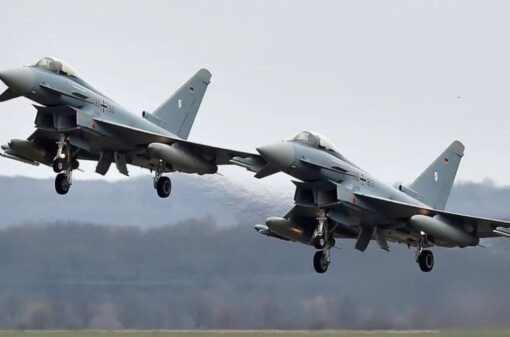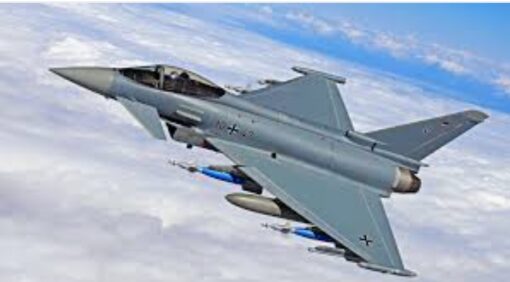Berlin, September 21, 2025 — Germany’s air force scrambled two Eurofighter jets to intercept a Russian reconnaissance aircraft flying over the Baltic Sea after the plane failed to file a flight plan and ignored standard communication protocols.
Officials identified the aircraft as an IL-20M, a Russian reconnaissance model, operating in international airspace but without an active transponder and with no radio contact. These conditions raised immediate security concerns, prompting Germany’s Quick Reaction Alert unit to deploy.
The Eurofighters launched from Rostock-Laage Air Base and quickly made visual contact with the Russian reconnaissance aircraft over the Baltic Sea.
In accordance with NATO air policing procedures, the German pilots photographed the IL-20M, verified its identity, and monitored its movements.
Once the interception was complete, Germany handed responsibility for the escort to Swedish NATO partners, who continued tracking the aircraft until it exited the monitored air zone. This seamless handover between NATO members reflected the alliance’s coordinated approach to aerial defense.

Although the Russian aircraft remained in international airspace, its failure to transmit identification signals and its lack of communication are widely viewed as deliberate provocations.
Analysts note that such flights are used to test NATO response times and readiness, particularly in regions like the Baltic Sea where tensions are high.
Germany’s defense ministry confirmed that the Eurofighters carried out their mission as planned, underscoring that these scrambles, while routine, highlight the vigilance required to protect European airspace.
The interception comes just days after Estonia accused Russia of violating its sovereign airspace when three MiG-31 fighter jets reportedly crossed into Estonian territory for several minutes. That incident triggered calls for NATO consultations under Article 4 and intensified diplomatic pressure on Moscow.
Taken together, these events highlight a pattern of Russian military flights challenging NATO members in the region, either through direct violations or by flying without proper identification in sensitive air corridors.
Russian officials have consistently denied any wrongdoing in such incidents, insisting that their aircraft operate within international law. In earlier cases, Moscow claimed its flights were carried out over neutral waters and posed no threat to NATO states.
However, European governments and military leaders argue that failing to file flight plans and flying with transponders switched off is a reckless practice that endangers civilian and military aviation alike.
Germany’s interception of the IL-20M adds to growing evidence of Russia’s increasingly aggressive aerial behavior near NATO’s eastern flank. Security experts warn that repeated encounters of this kind create a serious risk of miscalculation or escalation, particularly if communication continues to be ignored.
When reconnaissance aircraft operate in crowded skies without identification signals, the potential for accidents or dangerous misunderstandings increases dramatically.

For NATO, the incident underscores the importance of the Baltic Air Policing mission, a collective effort by alliance members to guard the skies over Estonia, Latvia, Lithuania, and northern Germany.
Under this mission, fighter jets from different NATO nations rotate deployments to ensure round-the-clock readiness against unannounced flights, unidentified aircraft, or deliberate attempts to test the alliance’s defenses.
The German Eurofighters’ swift interception demonstrates the mission’s effectiveness but also highlights the persistent pressure NATO faces from Russian aerial maneuvers.
European leaders have expressed concern over these developments, describing them as destabilizing and provocative.
Estonian officials have called the recent incursions “unprecedentedly brazen,” while German officials stressed that such interceptions, though handled professionally, remind the public of the fragility of European security.
Diplomatic discussions within NATO are already underway, with several members considering whether to increase patrols or update rules of engagement in response to Russia’s persistent reconnaissance flights.
Security analysts emphasize that these incidents are not only about testing reaction times but also about intelligence gathering. By flying reconnaissance aircraft like the IL-20M near NATO borders, Russia is believed to be probing radar capabilities, communication systems, and overall alliance readiness.
Each interception provides NATO with valuable information as well, including photographic evidence and radar data that contribute to understanding Russian military behavior in the region.
Germany’s decision to scramble Eurofighters over the Baltic Sea demonstrates both readiness and restraint. While no airspace violation occurred, the lack of a flight plan and transponder signal meant the aircraft was effectively flying “dark,” which aviation authorities consider dangerous and unacceptable.
By intercepting and monitoring the plane without escalation, Germany fulfilled its NATO responsibilities and sent a clear signal that unidentified aircraft will not go unchecked.
As the Baltic region remains on edge, observers warn that such incidents are likely to continue. With tensions between Russia and NATO already high, every unidentified flight risks sparking wider diplomatic disputes or, in the worst case, accidental confrontation.
The episode illustrates the fine line between routine military activity and potential crisis, reinforcing the need for constant vigilance, effective communication, and diplomatic efforts to prevent escalation.

Germany’s scramble of Eurofighter jets against a Russian reconnaissance aircraft over the Baltic Sea adds another chapter to the increasingly strained relations between Russia and NATO.
While Moscow continues to deny provocations, the alliance remains firm in its commitment to safeguarding European skies.
For now, the interception has ended without further incident, but the message is clear: NATO will respond swiftly whenever unidentified aircraft appear in sensitive zones, ensuring that air sovereignty and flight safety are not compromised.


